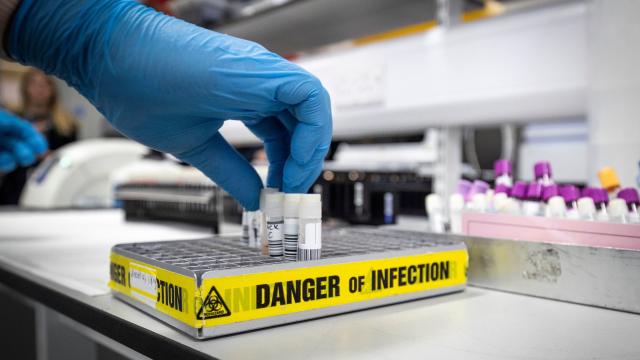A wave of attention is once again being paid to studies suggesting that the coronavirus behind covid-19 has mutated, possibly into a form that’s more infectious. But while the basic science of this research may be legitimate, it isn’t as worrisome as some headlines might lead you to believe — the virus is not becoming capable of ripping through masks or surviving soap and water, and the “new” strain is the same one the U.S. has been dealing with for months now.
On Wednesday, a large team of scientists released a paper on the preprint website medRxiv, a repository of preliminary research that hasn’t yet gone through the typical peer-review process. In it, they detail how they genetically sequenced over 5,000 samples of the coronavirus, SARS-CoV-2, that were collected from patients in the Houston, Texas area between March and July 2020. Over that time, they documented a change in the virus’s genetics, marked clearly by the emergence of two different waves of covid-19 outbreaks in the area.

The most potentially important change involves a mutation in the spike protein of the virus — the key that lets the virus get into our cells, to put it simply — called D614G. During the second wave, which they placed as starting in late May, over 99% of strains collected had the D614G mutation. Moreover, compared to the first wave of infections, patients on average had higher levels of the virus in their system during this second wave. That could suggest that D614G strains of the coronavirus are better at infecting and replicating inside our cells, the authors wrote, which could possibly also make the virus better at spreading to others.
Back in May, scientists at the Los Alamos National Laboratory in New Mexico were some of the first to describe the emergence of the D614G form of the virus, providing evidence that this mutation had become more common and eventually ever-present in strains collected over time, compared to the earliest cases in China, where the first known outbreaks of covid-19 occurred last winter. They similarly theorised that D614G made the virus better at infecting us.
Since then, more research has come out lending support to this theory, with the latest being the Houston study. But we still don’t have direct evidence that D614G strains are more infectious than the SARS-CoV-2 strain that first appeared in China, and this latest study doesn’t provide that either. As we know now, the coronavirus spread from Europe to most everywhere else in the world, including the U.S. Whether the D614G strain became dominant because it was more contagious or simply by chance isn’t clear.
“Those studies should be done, but for now, this is more of the same: It’s more common, but that doesn’t tell us much about whether it actually does anything,” said Angela Rasmussen, a virologist from Columbia University not affiliated with the research.
Perhaps more important is that no one, including the researchers studying D614G, thinks this mutation has actually made the virus deadlier or more likely to sicken us, something that seems to get lost in the headlines discussing this research.
“We found little evidence of a significant relationship between virus genotypes and altered virulence,” the authors of this new study wrote.
Even if the D614G form of the virus is really more infectious than before, it likely doesn’t change things on the ground. It’s the D614G form that most of the world, especially the U.S., has been battling all this time, so these studies aren’t identifying a mutation that threatens to make the virus any worse than the status quo. Though this new paper highlights that D614G strains were 99% common in the second wave of infections in Houston, for instance, you have to read it in full to find out that 82% of strains during the first, smaller wave also had the D614G mutation.
“It makes sense that it’s the most frequent variant observed now, as it was already the dominant circulating variant in May,” Rasmussen noted.
It’s certainly important to chronicle the genetic evolution of the coronavirus (and any potentially dangerous germ) and to identify potential mutations that could be affecting how the virus interacts with people. But both scientists and journalists have to be careful about overhyping the implications of this research, which has to be replicated and ideally studied through experiments that can directly show the effects of a mutation.
Viruses and bacteria mutate all the time, and mostly, these mutations don’t actually change much. Even if a mutation could have a beneficial effect for a germ, it still has to become widely passed on, which is no sure bet. For instance, a mutation that makes a germ better at replicating may not actually cause it to spread more, because it could also make the host so sick that they die before passing the infection to others.
David Morens, an epidemiologist and scientific advisor with the National Institute of Allergy and Infectious Diseases, discussed the Houston study with the Washington Post, saying: “Wearing masks, washing our hands, all those things are barriers to transmissibility, or contagion, but as the virus becomes more contagious it statistically is better at getting around those barriers.” Unfortunately, some media outlets took this quote and ran with it. Fox News’ headline: “Coronavirus mutation emerges that may bypass mask-wearing, hand-washing protections.” Which, no.
The wrong kind of widely spread mutation in the coronavirus could definitely affect any potential treatments or vaccines that we’re developing against it. But so far, we haven’t seen evidence of that happening. And safe to say, viruses don’t tend to mutate tiny hands that can rip through physical barriers like masks. Similarly, no one is worried about the virus becoming immune to soap and water.
Things could always change, and we should be prepared for the worst. But right now, the virus we’re facing doesn’t seem to be any more — or less — a threat than in the early days of the pandemic, at least based on the research about D614G collected to date.
